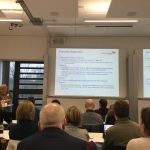On Thursday 2nd February I attended an event at the University of Bath entitled “Assessment and Feedback: Transforming Curricula and Assessment in HE.” There were many interesting sessions , of which the following were some of my personal highlights.
Dr Alex Buckley from the University of Strathclyde spoke about their use of the TESTA approach to reviewing assessment at a Programme level. Funded by the HEA, the project, standing for Transforming the Experience of Students Through Assessment, originally involved four partner institutions, Bath Spa, Chichester, Winchester and Worcester. It is now used in over 50 universities in an attempt to address deep challenges of assessment which Alex stressed need to be considered at Programme level.
The TESTA website contains further information and resources on this approach, including a manual on how to implement it. Alex explained that it involves triangulating data from a programme audit, an assessment experience questionnaire for students and focus groups. At Strathclyde those programmes who have engaged with TESTA have found it an extremely useful diagnostic tool as well as helping colleagues to think differently about assessment. After the process, programme teams have a workshop with educational developers where they consider practical changes that can be made which address the TESTA findings. The TESTA website contains case studies and best practice guides with concrete suggestions. An example is reducing reliance on formal documentation to communicate standards, and putting greater effort into providing exemplars in order make explicit, and open to discussion, the meaning of assessment criteria and enable to students internalise these through marking exercises and self and peer assessment in relation to the exemplars.
Kay Sambell from Edinburgh Napier University expanded in the afternoon on Alex’s point that we need to facilitate student engagement with feedback rather than simply flagging up when feedback is being provided. However both Kay and Jane Rand recognised that this can be easier said than done. Literature provided evidence of the effectiveness of this a decade ago, Jane said, but much practice hasn’t changed.
Kay went on to show some practical strategies that can be used. Her work is based on the Assessment Standards Knowledge Exchange at Oxford Brookes, which provides a range of useful resources. She also referred to the work of Winstone, Nash, Parker & Rowntree (2016) entitled Supporting Learners’ Agentic Engagement With Feedback: A Systematic Review and a Taxonomy of Recipience Processes, which emphasises the importance of “proactive recipience” of feedback.
Kay talked about dialogic use of exemplars, which can take different forms; complete or part of an assignment, authentic or re-created, annotated with feedback or not. She went on to give an example of a peer review workshop from her own practice, the process for which is outlined in the photo on the right. Students really valued this opportunity for extended dialogue around assessment criteria.
Students really valued this opportunity for extended dialogue around assessment criteria.
Kay also referred to the work of Nicol, Thomas and Breslin on feedback production being recognised as just as valuable for learning as receipt of feedback. She recognised that students are sometimes reluctant to engage with engagement activities (such as peer review)! However, when they do engage they find them extremely useful, and she has found that exemplar assignments are highly effective as “vicarious peer assessment”. Kay mentioned the work of Carless and Chan on managing dialogic use of exemplars. This contains analysis of how teachers can orchestrate dialogue around exemplars. They suggest in the paper that ” the dialogic use of exemplars should be a core aspect of teachers’ repertoire of assessment for learning strategies, in that the development of student skills in making academic judgements is fundamental to the university experience.” This is a point often made by D Royce Sadler, well known for his work on conditions necessary for students to benefit from feedback (Sadler, 1989) . In his own teaching Sadler makes use of a version of exemplars in the peer review of formative writing his students do. He puts his own attempt at the writing task in with his students’ which are distributed and peer reviewed. Sadler describes this in more detail in “‘Opening up feedback: Teaching learners to see“.
References
David Carless & Kennedy Kam Ho Chan (2016): Managing dialogic use of exemplars, Assessment & Evaluation in Higher Education
David Nicol, Avril Thomson & Caroline Breslin (2014) Rethinking feedback practices in higher education: a peer review perspective, Assessment & Evaluation in Higher Education, 39:1, 102-122
Sadler, D. R. (2013) Opening up feedback: Teaching learners to see” ( In Merry, S., Price, M., Carless, D., & Taras, M. (Eds.) Reconceptualising Feedback in Higher Education: developing dialogue with students. (Ch. 5, 54-63). London: Routledge.
Sadler, D. R. (1989). Formative assessment and the design of instructional systems. Instructional Science, 18, 119-144
Naomi E. Winstone, Robert A. Nash, Michael Parker & James Rowntree (2016): Supporting Learners’ Agentic Engagement With Feedback: A Systematic Review and a Taxonomy of Recipience Processes, Educational Psychologist